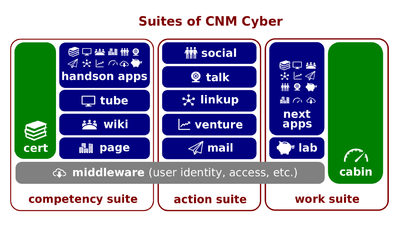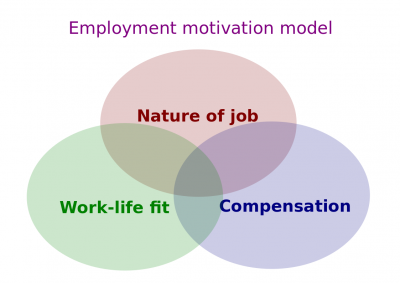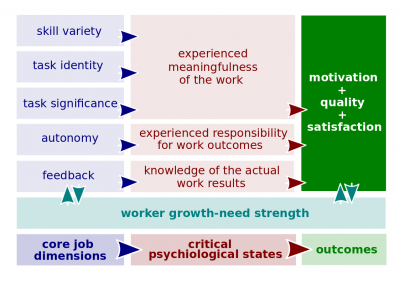Difference between revisions of "Nature of Work"
(→See also) |
|||
| (70 intermediate revisions by 3 users not shown) | |||
| Line 1: | Line 1: | ||
| − | [[Work | + | [[File:Cnm-digital.png|400px|thumb|right|[[CNMCyber suite]]s]][[Nature of Work]] (hereinafter, the ''Lesson'') is the [[lesson]] of [[CNMCyber]] that introduces its participants to [[work characteristic]]s and related topics. The ''Lesson'' belongs to the '''[[Introduction to Employment]]''' session of [[EmployableU Concepts]]. |
| − | |||
| − | |||
| − | + | The ''Lesson'' is made up of five [[lectio]]s. At [[CNMCyber]], the word, [[lectio]], is used for a lesson part. | |
| − | |||
| − | |||
| − | |||
| − | |||
| − | The | + | ==Summaries== |
| − | + | ===Predecessor=== | |
| + | :The predecessor lesson is [[Nature of Occupations]]. | ||
| − | [[ | + | ===Outline=== |
| + | :{|class="wikitable" width=100% style="text-align:center;" | ||
| + | |+[[Nature of Work]] | ||
| + | |width=25%|[[Lectio]]s | ||
| + | !#!!Referred topics | ||
| + | |- | ||
| + | ![[Work Characteristics]] | ||
| + | |1||[[Work characteristic]], [[work tool]], [[work activity]], [[work context]], [[work style]], [[work value]] | ||
| + | |- | ||
| + | ![[Work Arrangements]] | ||
| + | |2||[[Work arrangement]], [[compressed workweek]], [[flextime]], [[telecommuting]], [[job sharing]] | ||
| + | |- | ||
| + | ![[Job Dimensions]] | ||
| + | |3||[[Job Characteristics Model]], [[skill variety]], [[task identity]], [[task significance]], [[autonomy]], [[feedback]], [[core job dimension]] | ||
| + | |- | ||
| + | ![[Task Attributes]] | ||
| + | |4||[[Job task]], [[task performance]], [[task structure]], [[structured task]], [[unstructured task]], [[task attribute]], [[consequence of error]], [[degree of automation]], [[freedom to make decisions]], [[frequency of decision-making]], [[impact on enterprise]], [[importance of being accurate]], [[importance of repeating same tasks]], [[level of competition]], [[time pressure]], [[work schedule]], [[work virtualization]] | ||
| + | |- | ||
| + | ![[Workplace Conditions]] | ||
| + | |5||[[Workplace condition]], [[workplace]], [[workspace]] | ||
| + | |} | ||
| − | + | ===Successor=== | |
| + | :The successor lesson is [[Labor Regulations]]. | ||
| + | ==2019 Work Environments presentation== | ||
| + | The video of the presentation is published on https://youtu.be/r--p5fmz4TA (5:29). Here is its full text. | ||
| − | == | + | ===Overview=== |
| − | The | + | :Welcome to ''Work Environments''. In this brief presentation, we are going to take a look at two models, one for employment motivation and another for job characteristics. A separate stop will be made by [[task structures]]. Let's move forward. |
| + | |||
| + | ===Employment motivation=== | ||
| + | :[[File:Employment-motivation.png|400px|thumb|right|[[Work Motivation Model]]]]We will start with employment motivation model which suggests that three demands are responsible for keeping us motivated on the jobs. | ||
| + | |||
| + | :The first is the job itself, the second is compensation for the job. Compensation consists of both cash and non-cash benefits and the third domain is life fit, it`s fit to ones life. Which can be a fit to ones’ values, lifestyles or schedules. Basically what a person has outside the job. Every one of these domains have both motivations and demotivation, so some factors can motivate us and some can demotivate us. | ||
| + | |||
| + | ===Job motivation=== | ||
| + | :[[File:Job-characteristics.png|400px|thumb|right|[[Job Characteristics Model]]]]There are several theories and the most popular I would say in organization behavior is the [[Job Characteristics Model]] which suggest or chunks job characteristics which motivate us in five core dimensions which are skill varieties, task identities, task significance and autonomy and feedback. The first three gives us a psychological state of experienced meaningfulness of the work. Autonomy experience responsibility for work outcomes, all three of these psychological states gives most of us motivational quality and satisfaction. | ||
| + | |||
| + | ===Core dimensions=== | ||
| + | :What are skills variety? Skills variety is degree to which job requires a variety of activities so we don`t get bored on the job. Task identity is the feeling that the job can be accomplished so you can see the progress and measure the progress so as to see where you are on these tasks. Tasks significance is the degree to which job requires or has substantial impact so it could be once again all three gives a meaningfulness in the job. | ||
| − | + | :Autonomy is the degree to which job provides substantial freedom, independence and discretion. And feedback is the degree to which carrying out the work activities required by job resolves an individual`s obtaining direct and clear about the effectiveness of his/her performance. | |
| − | + | ===Environmental job characteristics=== | |
| − | + | :Obviously all three core dimensions which are responsible according to the theory form motivation, doesn't cover all job characteristics. | |
| − | |||
| − | + | :Taking a look at consequences of error, it`s definitely an adjusting factor. If the consequence is huge, why would anyone like to have more autonomy, probably it`s better to have some kind of a backup. | |
| + | :The same degree of automation, some jobs are more automated some jobs are not. Some are more scared of computers and robots, some are less. | ||
| − | + | :Of course we have freedom to make decisions, frequency of decision making, impact on enterprise, importance of being exact and a level of competition, some jobs are more competitive some are less, time pressure, work schedule and work virtualization. For instance, we Educaship Alliance LLC tend to work more virtual rather than physical. To sum up, we talked about working environments, we have taken a look at employment motivation model, job characteristics model, and we touched a little bit to structure and the next will be competencies required at work. | |
| − | : | ||
| − | == | + | ===Summary=== |
| − | + | :This concludes the ''Work Environments'' presentation. We have defined [[work environment]] and taken a look at the [[Work Motivation Model]] and [[Job Characteristics Model]]. We mentioned [[employee compensation]] and [[work-life fit]]. Separate stops were made by [[core job dimension]]s and various parts of [[task structure]]s. If you haven't done yet so, you are now welcome to move to [[Sought Competences]]. | |
| − | |||
[[Category: Orientation Curriculum]][[Category:Presentations]] | [[Category: Orientation Curriculum]][[Category:Presentations]] | ||
Latest revision as of 19:33, 29 October 2023
Nature of Work (hereinafter, the Lesson) is the lesson of CNMCyber that introduces its participants to work characteristics and related topics. The Lesson belongs to the Introduction to Employment session of EmployableU Concepts.
The Lesson is made up of five lectios. At CNMCyber, the word, lectio, is used for a lesson part.
Contents
Summaries
Predecessor
- The predecessor lesson is Nature of Occupations.
Outline
Successor
- The successor lesson is Labor Regulations.
2019 Work Environments presentation
The video of the presentation is published on https://youtu.be/r--p5fmz4TA (5:29). Here is its full text.
Overview
- Welcome to Work Environments. In this brief presentation, we are going to take a look at two models, one for employment motivation and another for job characteristics. A separate stop will be made by task structures. Let's move forward.
Employment motivation
- We will start with employment motivation model which suggests that three demands are responsible for keeping us motivated on the jobs.
- The first is the job itself, the second is compensation for the job. Compensation consists of both cash and non-cash benefits and the third domain is life fit, it`s fit to ones life. Which can be a fit to ones’ values, lifestyles or schedules. Basically what a person has outside the job. Every one of these domains have both motivations and demotivation, so some factors can motivate us and some can demotivate us.
Job motivation
- There are several theories and the most popular I would say in organization behavior is the Job Characteristics Model which suggest or chunks job characteristics which motivate us in five core dimensions which are skill varieties, task identities, task significance and autonomy and feedback. The first three gives us a psychological state of experienced meaningfulness of the work. Autonomy experience responsibility for work outcomes, all three of these psychological states gives most of us motivational quality and satisfaction.
Core dimensions
- What are skills variety? Skills variety is degree to which job requires a variety of activities so we don`t get bored on the job. Task identity is the feeling that the job can be accomplished so you can see the progress and measure the progress so as to see where you are on these tasks. Tasks significance is the degree to which job requires or has substantial impact so it could be once again all three gives a meaningfulness in the job.
- Autonomy is the degree to which job provides substantial freedom, independence and discretion. And feedback is the degree to which carrying out the work activities required by job resolves an individual`s obtaining direct and clear about the effectiveness of his/her performance.
Environmental job characteristics
- Obviously all three core dimensions which are responsible according to the theory form motivation, doesn't cover all job characteristics.
- Taking a look at consequences of error, it`s definitely an adjusting factor. If the consequence is huge, why would anyone like to have more autonomy, probably it`s better to have some kind of a backup.
- The same degree of automation, some jobs are more automated some jobs are not. Some are more scared of computers and robots, some are less.
- Of course we have freedom to make decisions, frequency of decision making, impact on enterprise, importance of being exact and a level of competition, some jobs are more competitive some are less, time pressure, work schedule and work virtualization. For instance, we Educaship Alliance LLC tend to work more virtual rather than physical. To sum up, we talked about working environments, we have taken a look at employment motivation model, job characteristics model, and we touched a little bit to structure and the next will be competencies required at work.
Summary
- This concludes the Work Environments presentation. We have defined work environment and taken a look at the Work Motivation Model and Job Characteristics Model. We mentioned employee compensation and work-life fit. Separate stops were made by core job dimensions and various parts of task structures. If you haven't done yet so, you are now welcome to move to Sought Competences.


